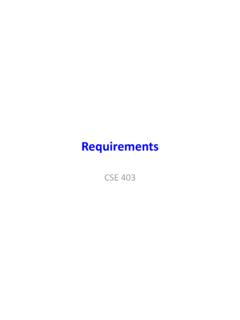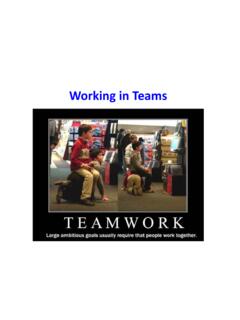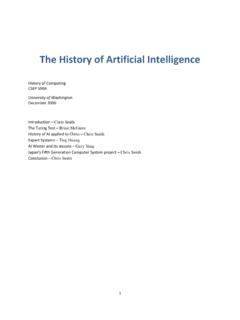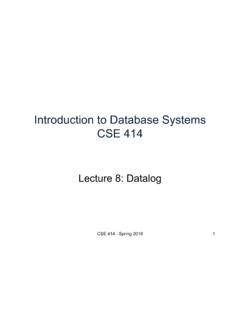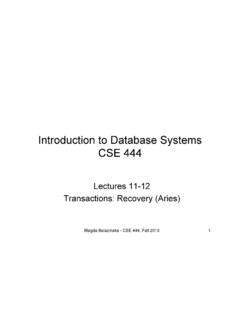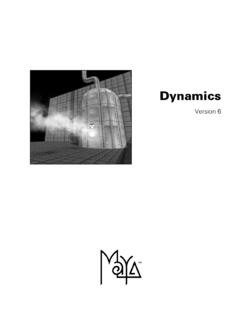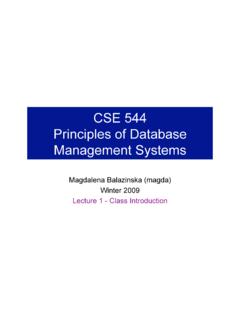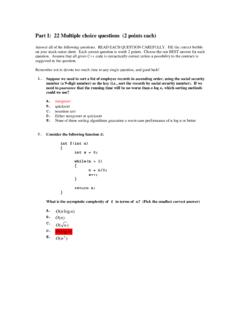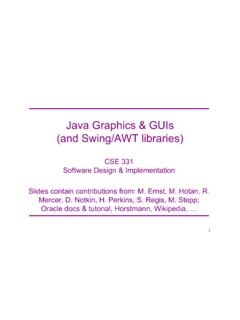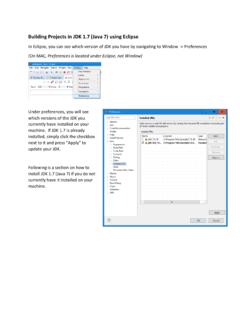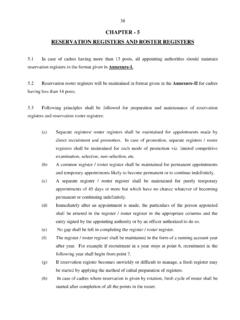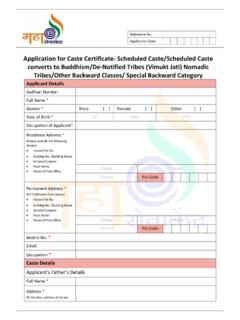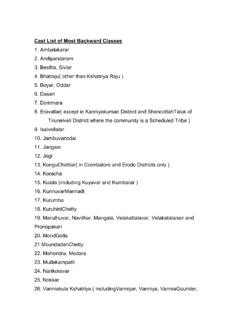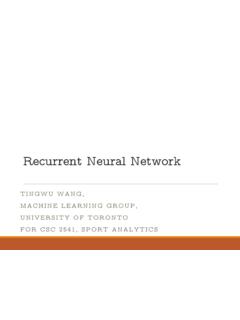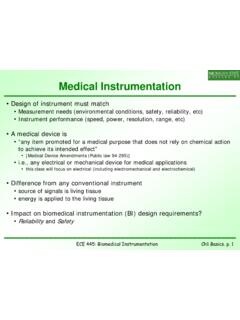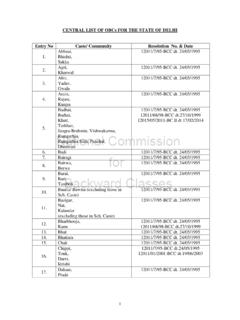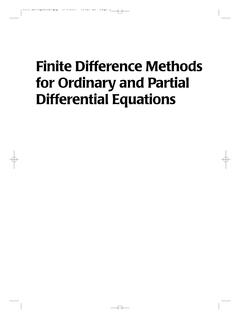Transcription of UML Class Diagrams - University of Washington
1 Emina Torlak 403: Software Engineering, Fall Class DiagramsOutline2 Designing classes Overview of UML UML Class Diagrams Syntax and semantics Examplesdesigndesign phase: from requirements to codeSoftware design4 Design: specifying the structure of how a software system will be written and function, without actually writing the complete implementation A transition from "what" the system must do, to "how" the system will do it What classes will we need to implement a system that meets our requirements? What fields and methods will each Class have? How will the classes interact with each other ?How to design classes ?5 Identify classes and interactions from project requirements: Nouns are potential classes , objects, and fields Verbs are potential methods or responsibilities of a Class Relationships between nouns are potential interactions (containment, generalization, dependence, etc.)How to design classes ?5 Identify classes and interactions from project requirements: Nouns are potential classes , objects, and fields Verbs are potential methods or responsibilities of a Class Relationships between nouns are potential interactions (containment, generalization, dependence, etc.)
2 Which nouns in your project should be classes ? Which ones are fields? What verbs should be methods? What are potential interactions between your classes ?Describing designs with CRC cards6 CRC ( Class -responsibility-collaborators) cards on top of the card, write down the name of the Class below the name, list the following: responsibilities: problems to be solved; short verb phrases collaborators: other classes that are sent messages by this classDescribing designs with UML diagrams7 Class diagram (today) Shows classes and relationships among them. A static view of the system, displaying what interacts but not what happens when they do interact. Sequence diagram (next lecture) A dynamic view of the system, describing how objects collaborate: what messages are sent and designs with UML: an overviewWhat is UML?9 Pictures or views of an OO system Programming languages are not abstract enough for OO design UML is an open standard; lots of companies use it What is legal UML?
3 A descriptive language: rigid formal syntax (like programming) A prescriptive language: shaped by usage and convention It's okay to omit things from UML Diagrams if they aren't needed by team/supervisor/instructorUML: Unified Modeling Language10 Union of Many Languages Use case Diagrams Class Diagrams Object Diagrams Sequence Diagrams Collaboration Diagrams Statechart Diagrams Activity Diagrams Component Diagrams Deployment Diagrams .. A very big language! Uses for UML11 As a sketch: to communicate aspects of system Forward design: doing UML before coding Backward design: doing UML after coding as documentation Often done on whiteboard or paper Used to get rough selective ideas As a blueprint: a complete design to be implemented Sometimes done with CASE (Computer-Aided Software Engineering) tools As a programming language: with the right tools, code can be auto-generated and executed from UML Only good if this is faster than coding in a "real" languagelearnUML Class diagramsWhat is a UML Class diagram?
4 13 A UML Class diagram is a picture of the classes in an OO system their fields and methods connections between the classes that interact or inherit from each other Not represented in a UML Class diagram: details of how the classes interact with each other algorithmic details; how a particular behavior is implementedDiagram of a single class14 Class name write interface on top of interfaces' names use italics for an abstract Class name Attributes (optional) fields of the Class Operations / methods (optional) may omit trivial (get/set) methods but don't omit any methods from an interface! should not include inherited methodsRectangle-width: int-height: int/area: double+Rectangle(w: int, h: int)+distance(r: Rectangle): doubleStudent-name: String-id: int-totalStudents: int#getID(): int~getEmail(): StringClass attributes (fields, instance variables)15 visibility+public#protected-private~pack age (default)/derived derived attribute: not stored, but can be computed from other attribute values specification fields from CSE 331 underline static attributesRectangle-width: int-height: int/area: double+Rectangle(w: int, h: int)+distance(r: Rectangle): doubleStudent-name: String-id: int-totalStudents: int#getID(): int~getEmail(): Stringvisibility name : type [count] = default_value visibility+public#protected-private~pack age (default) parameters listed as name : type underline static methods omit return_type on constructors and when return type is voidClass operations / methods16 Rectangle-width: int-height: int/area: double+Rectangle(w: int, h: int)+distance(r.)
5 Rectangle): doubleStudent-name: String-id: int-totalStudents: int#getID(): int~getEmail(): Stringvisibility name(parameters) : return_typeComments17 interface CloneableRepresented as a folded note, attached to the appropriate Class /method/etc by a dashed lineCloneable is a tagging interface with no methods. The clone() methods is defined in the Object between classes18 Generalization: an inheritance relationship inheritance between classes interface implementation Association: a usage relationship dependency aggregation compositionGeneralization relationships19 Hierarchies drawn top-down Arrows point upward to parent Line/arrow styles indicate if parent is a(n): Class : solid line, black arrow abstract Class : solid line, white arrow interface: dashed line, white arrow Often omit trivial / obvious generalization relationships, such as drawing the Object Class as a parentRectangle-x: int-y: int+Rectangle(x: int, y: int)+distance(r: Rectangle): doubleRectangularShape-width: int-height: int/area: double+contains(x: int, y: int): boolean+getArea(): double interface Shape+getArea().
6 DoubleAssociational (usage) relationships20 Class AClass *kAssociational (usage) (how many are used) * (zero or more) 1 (exactly one) (between 2 and 4, inclusive) * (3 or more, * may be omitted) Class AClass *k11 Associational (usage) (how many are used) * (zero or more) 1 (exactly one) (between 2 and 4, inclusive) * (3 or more, * may be omitted) (what relationship the objects have) Class AClass *k121 Associational (usage) (how many are used) * (zero or more) 1 (exactly one) (between 2 and 4, inclusive) * (3 or more, * may be omitted) (what relationship the objects have) (direction) Class AClass *k1231 Association multiplicities21 One-to-one Each car has exactly one engine. Each engine belongs to exactly one car. One-to-many Each book has many pages. Each page belongs to exactly one *Association types22 CarEngine11 Association types22 Aggregation: is part of symbolized by a clear white diamondCarEngine11 Association types22 Aggregation: is part of symbolized by a clear white diamond Composition: is entirely made of stronger version of aggregation the parts live and die with the whole symbolized by a black diamondCarEngine11 BookPage1*Association types22 Aggregation: is part of symbolized by a clear white diamond Composition: is entirely made of stronger version of aggregation the parts live and die with the whole symbolized by a black diamond Dependency: uses temporarily symbolized by dotted line often is an implementation detail, not an intrinsic part of the object's stateCarEngine11 BookPage1*LotteryRNGA ggregation / composition example23 If the cinema goes away so does the box office: composition but movies may still exist.
7 AggregationCinemaBoxOffice11 Movie**Checkout ScreenDVDVHSGameRental ItemRental * classGeneralizationClass diagram example: video store24 Class diagram example: people25 Let s add visibility + main (args : String[])+ toString() : String- firstName : String- lastName : String- homeAddress : Address- schoolAddress : Address+ toString() : String- streetAddress : String- city : String- state : String- zipCode : longAddressClass diagram example: student261100 StudentTools for creating UML diagrams27 Violet (free) Rational Rose Visual Paradigm UML Suite (trial) There are many others, but most are commercialWhat (not) to use Class Diagrams for28 What (not) to use Class Diagrams for28 Class Diagrams are great for: discovering related data and attributes getting a quick picture of the important entities in a system seeing whether you have too few/many classes seeing whether the relationships between objects are too complex, too many in number, simple enough, etc. spotting dependencies between one Class /object and anotherWhat (not) to use Class Diagrams for28 Class Diagrams are great for: discovering related data and attributes getting a quick picture of the important entities in a system seeing whether you have too few/many classes seeing whether the relationships between objects are too complex, too many in number, simple enough, etc.
8 Spotting dependencies between one Class /object and another Not so great for: discovering algorithmic (not data-driven) behavior finding the flow of steps for objects to solve a given problem understanding the app's overall control flow (event-driven? web-based? sequential? etc.)Summary29 A design specifies the structure of how a software system will be written and function. UML is a language for describing various aspects of software designs. UML Class Diagrams present a static view of the system, displaying classes and relationships between them.
